But living cells, even the simplest ones, are made up of complex molecules of
various organic compounds, not just of separate chemical elements. How did these
molecules come about? Because many of these compounds have been found
elsewhere in the Solar System, it has been assumed that they form naturally,
given enough time. In 1953 two scientists at the University of Chicago, Harold
Urey and Stanley Miller, conducted what has since been called “a most striking
experiment.” In a pressure vessel they mixed simple organic molecules of
methane, ammonia, hydrogen, and water vapor, dissolved the mixture in water
to simulate the primordial watery “soup,” and subjected the mixture to electrical
sparks to emulate primordial lightning bolts. The experiment produced several
amino and hydroxy acids-the building blocks of proteins, which are essential to
living matter. Other researchers later subjected similar mixtures to ultraviolet
light, ionizing radiation, or heat to simulate the effects of the Sun’s rays as
well as various other types of radiation on the Earth’s primitive atmosphere and
murky waters. The results were the same.
But it was one thing to show that nature itself could, under certain conditions,
come up with life’s building blocks-not just simple but even complex organic
compounds; it was another thing to breathe life into the resulting compounds,
which remained inert and lifeless in the compression chambers. “Life” is
defined as the ability to absorb nutrients (of any kind) and to replicate,
not just to exist. Even the biblical tale of Creation recognizes that when
the most complex being on Earth, Man, was shaped out of “clay,” divine
intervention was needed to “breathe the spirit/breath of life” into him.
Without that, no matter how ingeniously created, he was not yet animate,
not yet living.
Zecharia Sitchen - Genesis Revisited
Regarding the most ancient gold mines of Monotapa in southern Zimbabwe, Zulu
legends hold that they were worked by “artificially produced flesh and blood
slaves created by the First People.” These slaves, the Zulu legends recount,
“went into battle with the Ape-Man” when “the great war star appeared in the
sky” (see Indaba My Children, by the Zulu medicine man
Credo Vusamazulu Mutwa).
The first American publication of Credo Mutwa includes sangoma magical
lore, prophecies, dreams, tales, and a rich mythology that reaches beyond
this Earth to an extraterrestrial origin.
We are informed via Zacharia Sitchen in The Wars of Gods and Men that the
Anunnaki were here on Earth for one reason...to find and mine gold. They used it as a
protective shield around their planet because like Earth, their atmosphere was thining.
The mining was hard labor and the Anunnaki complained bitterly so to ease their burden,
slaves were created to toil in the mines. The Gods that created the 'slave workers'
also created us.
The Egyptian Stand on Race
The racial make-up of the Nile Valley Region of Africa and of
ancient Egypt in particular, continues to be a topic of controversy.
Some have suggested that the ancient Egyptians were Semites. Others
have suggested that they were whites. The roots of ancient Egyptian
culture have been searched for within Europe and Mesopotamia. The
only region left out of the equation thus far has been Africa
itself. So exactly who were these peoples who inhabited the ancient
Nile Valley?
So what race were the Egyptians?
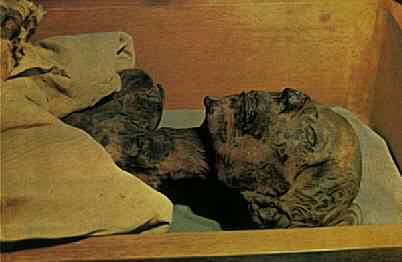
Professor P. F. Ceccaldi, with a research team, studied some hairs from the mummy's scalp.
Ramesses II was thought to be 87 years-old when he died, and his hair had turned white.
Ceccaldi determined that the reddish-yellow color of the hair was due to a dye with a
dilute henna solution. Many Egyptians dyed their hair, and this personal habit was preserved
by the embalmers. However, traces of the hair's original color remained in the roots.
Microscopic examinations showed that the hair roots contained natural red pigments,
and that therefore, during his younger days, Ramesses II had been a red head. Analysis
concluded that these red pigments did not result from the hair somehow fading, or
otherwise being altered after death, but did represent Ramesses' natural hair color.
Ceccaldi also studied the cross-section of the hairs, and determined from their oval
shape, that Ramesses had been "cymotrich" (wavy-haired). Finally, he stated that
such a combination of features showed that Ramesses had been a "leucoderm"
(white-skinned person).
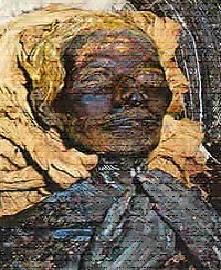 Queen Tiy (Taia,Tyre)
Father was Yuya - Mother Thuya - Mother and wife of Akhenaten (Pharaoh
Priestess of the God Amun AmenhotepIII who was the father of Aye whom replaced
Tutankhamun after his death)
Queen Tiy (Taia,Tyre)
Father was Yuya - Mother Thuya - Mother and wife of Akhenaten (Pharaoh
Priestess of the God Amun AmenhotepIII who was the father of Aye whom replaced
Tutankhamun after his death)
She was called the most brilliant and famous of Egypt's queens in 18th Dynasty Egypt.
We see that she has blond hair and caucasian features. Queen Hatshepsut had blond hair.
A wooden statue of King Hor shows him to have very blue eyes. There are countless
examples of Nordic influence in Egypt on display. The ruling elite began to disintegrate
when they married outside of their own race. In fact that was the beginning of the end.
The term "blue blood" first arose in Egypt. It referred to the fact that their blue veins
could be seen through their pale skin.
This link settles the question once and for all. The real Egyptians were not Black!
The White History of Egypt and here's
another one Red Haired Mummies of Egypt
and another..Pro-White Article
As a people, the Egyptians had a very racist and antagonistic stand vis-à-vis all
other races. They considered Semitic Hebrews, Canaanites, Libyans, Black Nubians
(even though Nubian Pharaohs ruled Egypt for 100 years), Ethiopians and other
non-Egyptians as sub-human. Hence, they treated the aforesaid Hebrew nomads
with disdain. It is, therefore, safe to say that most Hebrews in Egypt were not
permitted to rise as a people and they suffered in ignorance and poverty.
This did not have anything to do with the 'color' of their skin - it had to do
with 'who' their god was....Who he still is!
The Evolutionists versus the Creationists
In 1871, when publishing his Descent of Man, Charles
Darwin coined the expression ‘missing link’ in relation to a perceived anomaly
in the human evolutionary progression. There was an undeniable inconsistency in the
supposed lineage which, at first, seemed like a gap in the sequence, but it
was soon realized that there was no gap, simply an unexplained link.
It is frequently alleged that Darwin taught that humans had descended
from early apes, such as chimpanzees, orang-utans and gorillas, but this
is nonsense: Darwin never taught that. If it were true, there would be no
chimpanzees, orang-utans or gorillas today. In the wider scheme of things,
it was logically conceived that humans must have evolved from a different
type of ape—a hipedal ground-dwelling ape, but there had been no archaeological
discovery which supported this theory. And so it was generally agreed that
there had to have been a sub-man, an ape-man, a dawn-man: a ‘missing link’.
The very idea of human evolvement from apes was, of course, anathema to the
Church, for it was contrary to the book of Genesis, which told how man (Adam)
was created in a unique and original adult form...but that isn't true either.
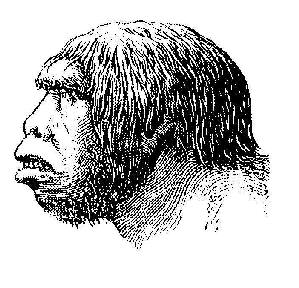 Darwin had been so sure about the possibility of a ‘missing link’
because of two significant finds during his own lifetime. In 1857, the
skeleton of a very primitive hunter had been discovered in the Neander
Valley, near Düsseldorf, in Germany, and his type was duly dubbed
‘Neanderthal’. Other discoveries have shown that the Neanderthalers
were prevalent in Europe, Asia and Africa, having existed from sometime
before 70,000 BC. They were thought to have evolved from an early form
of homo erectus through a gradual process from about 300,000 BC.
Darwin had been so sure about the possibility of a ‘missing link’
because of two significant finds during his own lifetime. In 1857, the
skeleton of a very primitive hunter had been discovered in the Neander
Valley, near Düsseldorf, in Germany, and his type was duly dubbed
‘Neanderthal’. Other discoveries have shown that the Neanderthalers
were prevalent in Europe, Asia and Africa, having existed from sometime
before 70,000 BC. They were thought to have evolved from an early form
of homo erectus through a gradual process from about 300,000 BC.
The problem with the Neanderthal breed was that, although they were
the primary hominoid race through the Old Stone Age (when fire, hand-axes
and flint tools were in use), they were not merely simpler and less
developed than ourselves, they were from another line altogether.
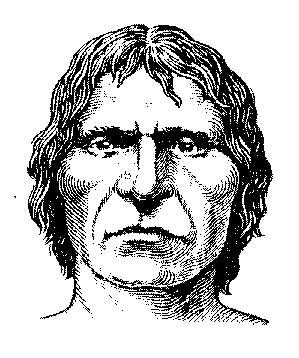 The other great discovery of the Darwinian age was made soon afterwards
in 1868, when the first examples of homo sapiens were unearthed at Cro-Magnon
in the Dordogne region of France. Unlike the crouched Neanderthalers with
their heavy brows, receding foreheads, protruding jaws and robust bone structure,
the Cro-Magnons (as the newly discovered people were called) were tall, upright,
broad-faced individuals, with a very differently structured brain cavity. In
terms of geological time, there appeared to be nothing to separate the late
Neanderthalers and the early Cro-Magnons, but they were as different from
each other as cattle are from horses. Not only that, but their cultures were
remarkably dissimilar, with the Cro-Magnons displaying an uncanny sophistication
in terms of their art, clothing, habitation and general lifestyle.
The other great discovery of the Darwinian age was made soon afterwards
in 1868, when the first examples of homo sapiens were unearthed at Cro-Magnon
in the Dordogne region of France. Unlike the crouched Neanderthalers with
their heavy brows, receding foreheads, protruding jaws and robust bone structure,
the Cro-Magnons (as the newly discovered people were called) were tall, upright,
broad-faced individuals, with a very differently structured brain cavity. In
terms of geological time, there appeared to be nothing to separate the late
Neanderthalers and the early Cro-Magnons, but they were as different from
each other as cattle are from horses. Not only that, but their cultures were
remarkably dissimilar, with the Cro-Magnons displaying an uncanny sophistication
in terms of their art, clothing, habitation and general lifestyle.
The apparent time-frame for the Neanderthal/Cro-Magnon crossover was about
35,000-30,000 BC, and they did exist as contemporaries for a time, thereby
proving that one did not evolve from the other. It is of particular interest
to note that there has never been a trace of any interbreeding between the
distinctly different strains, and as the Cro-Magnons grew to prominence, so
the Neanderthalers became totally extinct.
Until quite recently, it was thought that perhaps today’s world supported
various peoples that were separately descended from each of these two key races,
but this theory has now been overturned. In July 1997, a breakthrough in genetic
analysis proved beyond doubt that modern homo sapiens-sapiens have
not the slightest trace of ancestry from the Neanderthalers. This was
ascertained when a team led by Dr Svante Pääho of the
University of Munich managed to extract DNA (deoxyribonucleic acid) from a
Neanderthal upper armbone fragment. Mitochondrial DNA is passed down, unchanged,
from mothers to their children, and, apart from the odd random mutation, all
today’s humans have very similar sequences.
It transpired that the
40,000-year-old Neanderthal DNA was so significantly different that it had to
be that of an entirely separate species. The scientists announced that, without
question, the Neanderthal race was a ‘biological dead end’ and that there is
no indication of any crossbreeding with Cro-Magnon homo sapiens. It was possible,
they said, that Neanderthalers and homo sapiens had some form of common ancestor
about 600,000 years ago, but this could not he proven and was of little
relevance.
The Cro-Magnon types appear to have developed out of Africa, Asia and
perhaps from the Balkan and Black Sea regions, spreading throughout Europe
century by century. As for their immediate ancestry, this is quite unknown,
while their semi-advanced culture (highly advanced for the time) and their
modern physique appear to have no scientifically obvious forerunners.
Equally startling was the earlier announcement in December 1996 that skulls
found on the Indonesian island of Java suggest that homo erectus (thought
to be 40,000 years ago) was still in existence 40,000 years ago. If so, this
means that the homo erectus apes did not evolve into the Neanderthales
with whom they lived side by side. This conclusion was reached by a team of
geologists led by Dr Carl Swisher of the Berkley Geochronology Center in
Califorinia. Using some teeth from the site where four homo erectus
skulls had been found, they applied an electron spin resonance dating method
to the tooth enamel. Also, as a cross check, other species were tested by a
process which analysed the radioactive decay of uranium in fossils.
Each of the separate tests threw up the same figures, and the skulls
were dated at between 53,000 and 27,000 BC - a 40,000 BC mean.
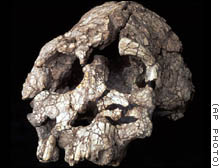 see...
New humaniod
skull found by Richard Leaky. ScienceDaily (Mar. 23, 2001) — March 21, 2001 – After the
partial skeleton of a 3.2-million-year-old human relative known as Lucy was found in
Ethiopia in 1974, many researchers believed her species – Australopithecus afarensis –
was the ancestor of modern humans. Now, in a stunning discovery, scientists working
in Kenya have found the skull and partial jaw of a completely different genus and
species, with a flattened face and small molar teeth much different than those
of afarensis. The discovery of the 3.2- to 3.5-million-year-old fossils raises the
question of whether modern humans descended from Lucy’s species or from
the newly discovered species.
see...
New humaniod
skull found by Richard Leaky. ScienceDaily (Mar. 23, 2001) — March 21, 2001 – After the
partial skeleton of a 3.2-million-year-old human relative known as Lucy was found in
Ethiopia in 1974, many researchers believed her species – Australopithecus afarensis –
was the ancestor of modern humans. Now, in a stunning discovery, scientists working
in Kenya have found the skull and partial jaw of a completely different genus and
species, with a flattened face and small molar teeth much different than those
of afarensis. The discovery of the 3.2- to 3.5-million-year-old fossils raises the
question of whether modern humans descended from Lucy’s species or from
the newly discovered species.
What we now know, and has been proven beyond doubt is that there is no
missing link in the way Darwin preceived it. The Cro-Magnon homo sapiens
did not descend from the Neandathalers; they were entirely different breeds
with entirely different DNA structures. It appears that we are descended from the
Afro-Asian Cro-Magnon types, but from what species did they evolve? Maybe this is
where the Enochian records come into play - the accounts of the Nepilim who spawned
an entirely new race prior to 35,000 BC, in the same era that the advanced Cro-Magnons
appeared, after which the backward Neanderthalers were gradually wiped out.
Noah's son Ham was not black as many uninformed African
American web sites have stated. Here is the evidence
Hams race ie., Cush ect.
(automatoc scroll down)
What we also know is that if the Nephilim created a new species by
interbreeding with the 'daughters of men', then these species were not of the Neanderthal
race because, as confirmed by Dr Svante Pääbo, mitochondrial DNA is a female
inheritance passed down from mothers. Could it be, therefore, that there was
another race contemporary with the Neanderthalers?
Laurence Gardner Genesis of the Grail Kings
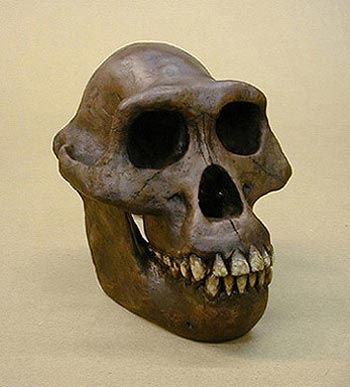 Donald Johanson and Tom Gray found
'Lucy'
(A. afarensis - "Lucy")on the 24th of November, 1974, at the site of Hadar in
Ethiopia. Another thirteen bodies were found, dubbed the 'First Family'.
These dated to 3.5 million BC. Footprints found in the area showed rounded
heels, raised arches, pronounced balls and a forward pointing big toe. These
bipedial anthropoids were physically in advance of the later Neanderthalers
and their remains were in Ethopia, the closed land mass to Saudi Arabia, which
sits between the Red Sea and the Persian Gulf.
Donald Johanson and Tom Gray found
'Lucy'
(A. afarensis - "Lucy")on the 24th of November, 1974, at the site of Hadar in
Ethiopia. Another thirteen bodies were found, dubbed the 'First Family'.
These dated to 3.5 million BC. Footprints found in the area showed rounded
heels, raised arches, pronounced balls and a forward pointing big toe. These
bipedial anthropoids were physically in advance of the later Neanderthalers
and their remains were in Ethopia, the closed land mass to Saudi Arabia, which
sits between the Red Sea and the Persian Gulf.
This species were also found in Iraq in the Ararat Mountains at a source of the
River Tigris which we observed as the area of the Garden of Eden. Professor Ralph
Soleki was investigating the Shanidar Cave when he found nine skeletons, four of
which had been crushed by a rockfall. These bones were about 40,000 years old but
the cave had been used for shelter from about 100,000 BC.
Another species that not many people talk about;
"Bigfoot!"
What Donald Johanson and Tom Gray found was an imperfect 'slave worker'
experiment of the Anunnaki, an 'ape like woman'.
There now exist, 'throw-backs' to this primitive creation. They are generally short
people about 5'5". They have feet that are 6 to 8 inches wide and very short. So 'deformed'
that they cannot wear shoes. They look like chimpanzees or gorillas in the face with
almost the same skull formation. We have seen this woman with our own eyes but apparently
no scientist that might see the connection has. This could be a breakthrough for the
evolutionists or it could be another huge puzzle that no one can solve.
But don't we have some evidence that chimpanzee DNA is closest to ours?
The simple answer is, "The Gods that created the 'slave workers' also created us". see
Chimp DNA and the 'Bigfoot" link.
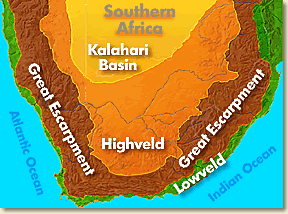
However, Jeffrey Swartz, an
evolutionary anthropologist at the University of Pittsburg, maintains
that man is closer to orangutans in gross morphology. Acts and Facts, 16 (5):5, 1987 see
The Creationists theory.
Everyone tries to explain away their theories with complicated techinical jargon but
the Anunnaki explanation in the Sumerian texts still fits better that any of these theories.
Where is gold mined?
Johannesburg South Africia.
The theory is known popularly as the (Recent) Out-of-Africa model, and academically
also as the recent single-origin hypothesis (RSOH), Replacement Hypothesis or Recent African
Origin (RAO) model. According to the theory, anatomically modern humans evolved solely in
Africa, between 200,000 and 100,000 years ago, with members of one branch leaving Africa
by 60,000 years ago and replacing all earlier human populations such as Neanderthals and
Homo erectus. The hypothesis originated in the 1980s based on a study of mitochondrial
DNA, and its proponents have since presented evidence based on physical anthropology as well.
What we found is two different cultures in two different places like the scientists say, at the same
time. One was very primitive, one was civilized. One had blonde hair and blue eyes and one had
black hair and brown eyes.
The Upper Paleolithic,
or Late Stone Age - Very broadly it dates to between 40,000 and 11,500 years ago. Crita 7400 B.C.-
exactly 3,600 years later - another abrupt advancement has been recognized. Scholars have
named it Neolithic (C "New Stone Age”); but its principal feature was the switch from stone
to clay and the appearance of pottery. And then, “suddenly and inexplicably” - but exactly 3,600 years
later - there blossomed out (crita 3800 B.C.) in the plain between the Euphrates and
Tigris rivers the high civilization of Sumer. It was followed, crita 3100 B.C.,
by the civilization of the Nile River; and crita 2800 B.C., the third civilization
of antiquity, that of the Indus River, made its appearance. These were the three
regions allotted to mankind; of them evolved the nations of the Near East, Africa,
and Indo-Europe - a division faithfully recorded in the Old Testament’s Table of Nations.
Evidence of cultivated crops turned up around 10,000 BC. LIMA, June 29, 2002(UPI) --
An archeologist from Vanderbilt University says domesticated squash seeds found in the Andes
of northern Peru are almost 10,000 years old. Researchers also found peanut hulls and
cotton fibers that date back 6,000 to 8,500 years, as well as stone hoes, furrowed garden
plots and small irrigation canals. The evidence of such plantings dating 5,000 to 9,000 years was
found on the western slopes of the Andes Mountains in the Nanchoc Valley, about 1,600
feet above sea level.
But scientists also assume there is a stage in the evolution of language somewhere between
Great ape language and fully developed modern human language. There isn't - because it didn't happen!
However, as we said, "beginning about 100,000 years ago, there is evidence of more sophisticated
behaviour, and by 50,000 years ago fully modern behaviour is thought to have developed
in various parts of Africa." Actually it did but under different circumstances than the theory
of evolution can explain or prove.
Science tells us today that there were four ‘Homonites’ - first is ‘Lucy’ along with its
guy ‘Dosnopytichest’, which died about 3 and a 1/2 million years - the Ice Age. Then next
came the ‘Homosepians’, who died about 5 hundred thousand years ago. Then came the
‘Neanderthal Man’, who died 500 hundred to forty thousand years ago. Then came the fourth
stage, ‘the Cromagnon’. ‘There is no link at all between these stages’ - According to P. P.
Grasse in 1971 who held the Chair of Evolutionary Studies in Paris, in Sojerion University.
He said… ‘It is absurd - We cannot say who were our ancestors based on
fossils’. I can give you a list of hundreds of scientists and Noble Prize winners who speak against
Darwin’s theory… Hundreds. If you know of Sir Albert George who got the Noble prize for inventing…
for inventing the Vitamin ‘C’ -
He wrote the book ‘The Can’t Ape and Man’, against Darwin’s Theory. Again if you read,
Sir Fred Hoyle’s work - he wrote several works against Darwin’s Theory. If you know
about Ruperts Albert, this person wrote a new theory of evolution against Darwin’s Theory.
from Forum
All humans possess similar linguistic abilities, and no child is born with a biological predisposition
favoring any one language or type of language. That also means there is no primate alive that can
be linked to humans except their ability to walk upright, and perhaps some of their bone structure.
The evolution of humans from apes is only a theory that in fact has never been proven, but
every documentary we see on television tries to shove this theory down our throats, even
though they have no real evidence.
see
Science Daily
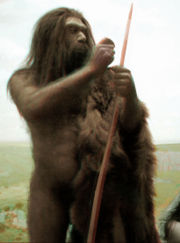 Humans are unique. They are born with an
ability to speak and learn. Of cource they inherent these traits from their parents. As they
grow, they are taught many other skills. This ability to reason and learn is taken for granted
because everyone has the ability. The ability to learn is in their DNA. But Neanderthals
didn't have this in their DNA nor did they have the ability to reason or solve a mathmetical problem.
Their DNA does not match that of modern humans. The use of language is one of the most conspicuous
and diagnostic traits that distinguish Homo sapiens from other species. Unlike writing, spoken
language leaves no trace. Hence linguists have to resort to indirect methods in trying to
decipher the origins of language.
Humans are unique. They are born with an
ability to speak and learn. Of cource they inherent these traits from their parents. As they
grow, they are taught many other skills. This ability to reason and learn is taken for granted
because everyone has the ability. The ability to learn is in their DNA. But Neanderthals
didn't have this in their DNA nor did they have the ability to reason or solve a mathmetical problem.
Their DNA does not match that of modern humans. The use of language is one of the most conspicuous
and diagnostic traits that distinguish Homo sapiens from other species. Unlike writing, spoken
language leaves no trace. Hence linguists have to resort to indirect methods in trying to
decipher the origins of language.
A 2003 study on Cro-Magnon
and Neanderthal mitochondrial DNA, published by an Italo-Spanish research team led
by David Caramelli, concluded that Neanderthals were far outside the modern human
range, while Cro-Magnons were well in the average of modern Europeans. mtDNA
retrieved from two Cro-Magnon specimens was identified as Haplogroup N. Haplogroup
N is found among modern populations of the Middle East, North Africa and Central Asia,
and its descendant haplogroups is found among modern Eurasian and Native
American populations.
Here's the headline of one of the more recent stories; (Mar. 20, 2008)
— New research adds to the evidence that chance, rather than natural selection, best explains why
the skulls of modern humans and ancient Neanderthals evolved differently. CHANCE? Are you kidding?
They've done this before when they can't find a resonable explaination....
(Aug. 16, 2007) — "Chance, not natural selection, best explains why the modern human skull looks so
different from that of its Neanderthal relative". They call this science? and see
Skulls
and see The origin of Language
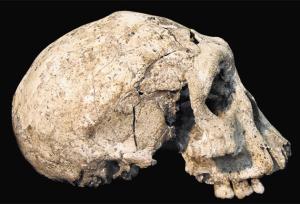
This page says; "Developed from an as yet
possibly unknown common ancestor independently." Australopithecines lived from
3.7 to 1 million years ago. They are not ancestral to the genus Homo, which
includes modern humans. Both Paranthropus and Homo genera were more advanced
in their behavior and habits than Australopithecus, which were little more than
bipedal chimpanzees. It has been suggested that the bipedal australopithecines
may possibly be the ancestors of the non-bipedal modern chimpanzees and gorillas,
a result of adaptation for reduced neotony (Neotony / Paedomorphism: A process
by which an organism retains characteristics of an earlier form of development,
often embryonic.) ...("The First Chimpanzee", John Gribbin/Jeremy Cherfas, 2nd
ed 2002). The photo is also a link to the Wikipedia encyclopedia.
The first fossils which were alleged to belong to this species were
found in a coal mine in 1924 in South African Taung region. The first
fossil defined as Australopithecus consisted of the face and
mandibulars of a young ape and a 410 cc. cranial capacity. The
discoverers of the fossil took it to professor Dr. Raymond Dart,
a professor of anatomy, from Witwater University.
According to the evolutionists the first ancestors of man called
Australopithecus, were creatures which had some humanlike but mostly
apelike characteristics. Some species of the Australopithecus have
allegedly become extinct and the others have developed into the
Homo (human) series. According to the evolutionists, the
Australopithecus series had mainly apelike characteristics and
the Homo series had common characteristics with the man of our
day. Especially Homo erectus and its subsequents were almost
identical with the contemporary man.
The scheme on the evolution of man which is sought to be kept alive, is actually based
on extremely subjective interpretations, distortions and even forgeries of the evolutionists.
In short, evolution of man is only a deception just like all the other
thesis of the theory of evolution…
see
Debunking the evolution theory
 Space images taken by NASA
reveal a mysterious ancient bridge in the Palk Strait between India and Sri
Lanka. The recently discovered bridge currently named as Adam's Bridge
is made of chain of shoals, c.18 mi (30 km) long. Between India & Sri Lanka
Space images taken by NASA
reveal a mysterious ancient bridge in the Palk Strait between India and Sri
Lanka. The recently discovered bridge currently named as Adam's Bridge
is made of chain of shoals, c.18 mi (30 km) long. Between India & Sri Lanka
source - see
Bridge
and Neolithic
The bridge's unique curvature and composition by
age reveals that it is man made. The legends as
well as Archeological studies reveal that the first
signs of human inhabitants in Sri Lanka date back
to the a primitive age, about 1,750,000 years ago
and the bridge's age is also almost equivalent.
Jericho
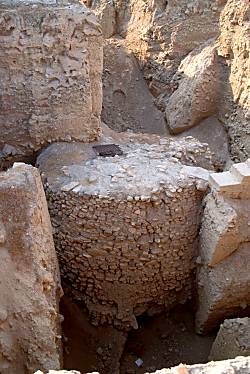 Discovered and excavated by
Kathleen Kenyon in her Trench I, the Neolithic tower was built and destroyed
in Pre-Pottery Neolithic A, which Kenyon dated to 8000-7000 B.C. The 8m
diameter tower stands 8m tall and was connected on the inside of a 4m thick
wall.
Discovered and excavated by
Kathleen Kenyon in her Trench I, the Neolithic tower was built and destroyed
in Pre-Pottery Neolithic A, which Kenyon dated to 8000-7000 B.C. The 8m
diameter tower stands 8m tall and was connected on the inside of a 4m thick
wall.
On the basis of this discovery, archaeologists have claimed that Jericho is
the "oldest city in the world." Clearly such monumental construction reflects
social organization and central authority, but there are good reasons to
question both its dating to the 8th millennium B.C. and its function as
a defensive fortification.
Jericho, which they claim is the world's first city, was built in the
Stone Age sometime between 11,000 and 10,000 years ago. The wild grasses its
inhabitants gathered were later domesticated. That is, they were genetically
engineered via selective breeding to produce ever fatter seeds. We
know the results today as wheat and barley. How did they know how to
genetically engineer plants?
Howard Bloom; The most prominent literary record of Jericho's
existence appears in
The Old Testament. In its pages Joshua's priests blow seven trumpets on
seven days to bring the walls of the city down. By the time this could
have taken place, Jericho was an old city, a very old one. During its
previous 7,000 years, its walls had crumbled many a time. Some collapses
had been caused by earthquake. Others had apparently been the result
of military assault. Little do those who read of Jericho in the Bible
suspect that the real importance of the place lays not in its appearance
in a holy book, but in its status as the world's first metropolis and
in its role, as Global Brain shows, as a catalyst which would change
the nature of human identity. see
Jericho and see Neolithic War
Back to the archaeological record
The early history of man in Iran goes back well beyond the Neolithic
(8.000 - 5.500 BC) period, it begins to get more
interesting around 10,000 BC, when people began to domesticate animals
and plant wheat and barley. The number of settled communities increased,
particularly in the eastern Zagros mountains, and handmade painted
pottery appears. Throughout the prehistoric period, from the middle
of the sixth millennium BC to about 3000 BC, painted pottery is a
characteristic feature of many sites in Iran.
Catalhoyuk in Central Turkey is the most advanced among all, but Cayonu in the
Eastern turkey goes back to around 7,250-6,750 BC. which makes it the oldest
Neolithic village in Tukey. The layout of Cayonu gives a square in the center of the
town with some rectangular shaped monumental buildings and houses around it.
Most of the buildings have the lower parts built out of stones and upper parts out
of mud bricks. Apparently the people of this town knew the farming techniques
and grew wheat, because many farming tools have been found at the site to prove
this fact. Besides the farming, the domesticated various animals such as sheep and
goats were also available in their towns. It is believed that the Dog was the first
domestic animal of this period. Also, the figurines of a female deity found at the
site are a clear evidence that the religion came to be an important event in their
lives. Later, this female deity came to be known as the Mother Goddess of Anatolia,
and has been worshipped for milleniums under the name " Cybele ".
Another site in the Western Turkey, called Hacilar has built a well advanced
civilization following the above town Cayonu. This town has been dated back to
7,040 BC. The excavations made here have revealed that this town had produced
agricultural produce such as wheat, barley and lentils. Also the remains of animals
such as goat, sheep, dog and cow have been uncovered at the site.
When we look at scientists who are credited with the most
important ideas of our time we find mainly Greeks, Europeans, Americans listed.
Yet western history seems to have been arbitrarily begun during the Greek era.
In fact, when we extend the boundaries of history to view the longer span of
history we find some amazing developments predating "modern" history originating
in India more than 5,000 years ago.
The ancient thinkers of India were not only scientists and mathematicians,
but also deeply religious, esteemed saints of their time. While it may surprise
some to think of religious sages as mundane scientists, the Indian view is that
religion (universal) and science are but two sides of the same coin - in short…
semantics. Whether one calls a natural phenomena wind or the wind god - Vayu - one
is speaking of the same thing.
Yet it seems that having a spiritual foundation not only brought out important
discoveries still in use today, but these discoveries also were helpful without
causing harm or destruction.
Around 800 BCE Sage Bharadwaj, was both the father of modern medicine,
teaching Ayurveda, and also the developer of aviation technology. He wrote the
Yantra Sarvasva, which covers astonishing discoveries in aviation and space sciences,
and flying machines - well before Leonardo DaVinchi's time. Some of his flying
machines were reported to fly around the earth, from the earth to other planets,
and between universes. His designs and descriptions have left a huge impression on
modern-day aviation engineers. He also discussed how to make these flying machines
invisible by using sun and wind force. There are much more fascinating insights
discovered by sage Bharadwaj.
Sage Kanad (circa 600 BCE) is recognized as the founder of atomic theory, and
classified all the objects of creation into nine elements (earth, water, light or
fire, wind, ether, time, space, mind and soul). He stated that every object in
creation is made of atoms that in turn connect with each other to form molecules
nearly 2,500 years before John Dalton. Further, Kanad described the dimension and
motion of atoms, and the chemical reaction with one another. The eminent historian,
T.N. Colebrook said, "Compared to scientists of Europe, Kanad and other Indian
scientists were the global masters in this field."
Sage Aryabhatt (b. 476 CE) wrote texts on astronomy and mathematics. He
formulated the process of calculating the motion of planets and the time of eclipses. Aryabhatt
was the first to proclaim the earth was round, rotating on an axis, orbiting the
sun and suspended in space. This was around 1,000 years before
Copernicus. He was a geometry genius credited with calculating pi to four
decimal places, developing the trigonomic sine table and the area of a triangle.
Perhaps his most important contribution was the concept of the zero. Details are
found in Shulva sutra. Other sages of mathematics
include Baudhayana, Katyayana, and Apastamba.
Algebra, arithmetic and geometry, planetary positions, eclipses,
cosmography, and mathematical techniques. The force of gravity.
In the field of mathematics, Bhaskaracharya II (1114 -
1183 CE) contributed to the fields of algebra, arithmetic and geometry. Two of his
most well known books are Lilavati and Bijaganita, which are translated in several
languages of the world. In his book, Siddhant Shiromani, he expounds on planetary
positions, eclipses, cosmography, and mathematical techniques. Another of his books,
Surya Siddhant discusses the force of gravity, 500 years before Sir Isaac Newton.
Sage Sridharacharya developed the quadratic equation around 991 CE.
Due to their intense spiritual life, they developed such power of discrimination
(vivek). Spirituality gives helpful direction and science brings speed. With a core of
spirituality, modern scientists' discoveries can quickly bring only helpful ideas to help
humanity. While Einstein is credited with the idea that one can travel faster than
the speed of light, it was written about centuries before in the ancient Vedic
literature. Perhaps it was Einstein's association with the famed Indian physicist,
Bose that led to his introduction to the views about the speed of light. Through deep
meditation and reading the ancient Vedic texts, who knows what our modern-day
scientists will discover?
Around 2700 years ago, as early as 700 BCE there existed
a giant University at Takshashila, located in the northwest
region of India.
Not only Indians but also students from as far as Babylonia,
Greece, Syria, Arabia and China came to study.
68 different streams of knowledge were on the syllabus.
Experienced masters taught a wide range of subjects.
Vedas, Language, Grammar, Philosophy, Medicine, Surgery, Archery, Politics, Warfare,
Astronomy, Accounts, commerce, Futurology, Documentation, Occult, Music, Dance,
The art of discovering hidden treasures, etc.
The minimum entrance age was
16 and there were 10,500 students.
The panel of Masters included renowned names like Kautilya,
Panini, Jivak and Vishnu Sharma.
source see
Amazing Science
Where it all started
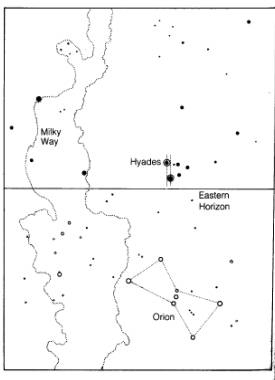 “This civilization called Egyptian in our period developed for a long time
in its early cradle . . . This cycle of civilization, the longest in history,
presumably lasted 10,000 years. This is a reasonable compromise between the
long chronology (based on data provided by Manetho -the last student of the
Ancient Egyptian Mystery School of Anu at Alexandria before it was invaded
by Alexander the Great in 330 BCE-- which places the beginning at 17,000 BCE)
and the short chronology [3100 BCE] of the moderns - for the latter are obliged
to admit that by 4245 BCE the Egyptians had already invented the calendar (which
necessarily requires the passages of thousands of years).”
“This civilization called Egyptian in our period developed for a long time
in its early cradle . . . This cycle of civilization, the longest in history,
presumably lasted 10,000 years. This is a reasonable compromise between the
long chronology (based on data provided by Manetho -the last student of the
Ancient Egyptian Mystery School of Anu at Alexandria before it was invaded
by Alexander the Great in 330 BCE-- which places the beginning at 17,000 BCE)
and the short chronology [3100 BCE] of the moderns - for the latter are obliged
to admit that by 4245 BCE the Egyptians had already invented the calendar (which
necessarily requires the passages of thousands of years).”
 Consequently, on earth at the Spring Equinox of 10,500 BC the ground plan
position of the Sphinx Rock Sculpture pointed directly east across the Nile
River to the helically rising Constellation Leo on the eastern horizon. The
First (“Great “ of Khufu) Pyramid, the Second (Khefra) Pyramid and Third
(Menkare) Pyramid on the ground reflected their analogous celestial positions in
the Orion (Ori-Anu) Constellation as its Belt Stars of Al Nitak, Al Nilam and
Mintaka respectively. Further explainations come from Uriel's Machine by
Christopher Knight and Robert Lomas.
Consequently, on earth at the Spring Equinox of 10,500 BC the ground plan
position of the Sphinx Rock Sculpture pointed directly east across the Nile
River to the helically rising Constellation Leo on the eastern horizon. The
First (“Great “ of Khufu) Pyramid, the Second (Khefra) Pyramid and Third
(Menkare) Pyramid on the ground reflected their analogous celestial positions in
the Orion (Ori-Anu) Constellation as its Belt Stars of Al Nitak, Al Nilam and
Mintaka respectively. Further explainations come from Uriel's Machine by
Christopher Knight and Robert Lomas.
For this reason we find that all the great ancient civilizations, having this basic knowledge,
centered their activities around a structure which embodied this knowledge, in as perfect a
degree as they were capable of assessing. There was always a structure—a building, a temple,
a pyramid, a complex sculpture or some such object—that captured this knowledge and served
as a point of focus for the collective energies and a point of reception of the cosmic dynamic
which needed to be synthetically absorbed into the Earth’s atmosphere—a ‘model of the
universe,’ as they are sometimes called. These were microcosmic replicas of the beyond in
relation to the Earth; above all, they held the key to the civilization’s being in Time.
More than a particular structure with its corresponding features, e.g. a pyramid with
is shafts connecting the so-called King and Queen’s chambers to certain stars at certain times
by pointing directly to them; a complex of such structures mirroring an entire constellation—
particularly, the constellation of Orion on the lands of Egypt. For the ancient Egyptians, the
construction was so accurate that the size of the various pyramids corresponded in relation
with the intensity of the brightness of the individual stars in Orion. And more, the pyramids in
this structural layout, corresponded in relation to the Nile as Orion was related to the stream
of stars forming the Milky Way Galaxy. The entire country was a consecrated expression of
sacred space.
…the Ancient Egyptians correlated the Nile with the ‘celestial river’ i.e., the Milky Way, and
this was known even by the Greeks. From the time of Homer, the Nile was associated with the
mythical sky river called either Okeanos or Eridanus. The Hellenic historian, A.B. Cook, was of
the opinion that Eridanus (which today is a faint constellation formed by a strong of stars joining
Rigel to Alchermor) was ‘at the outset none other than the Milky Way,’ and that in pre-Greek times,
Okeanos ‘simply meant the Galaxy’ i.e. the Milky Way. more...see
Sacred Space
We have found more evidence that Khufu did not build the great pyramid.
see..
The Inventory Stella
The Nile River flows south to north just east of the Giza
Limestone Rock Plateau on earth analogous to the celestial Milky Way spanning
the length of our galaxy just east of the Orion Constellation in the sky along a
south to north course. This connects with the words of Thoth seen on
Passage of Secrets 2.
this info came from.. Questionable Facts
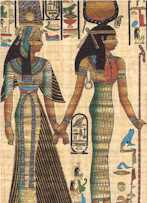
Note; The above page hosts a controversial theory. We do not agree that Anu or any other biblical
hero was black as referenced by the godly figure on the previous page who had blond hair, blue eyes
and light skin. The Sumerian texts report that the Egyptian people were light skined with straight
black hair as we have seen in numberous Egyptian motifs. As the people became mixed they
sported black wigs to carry on a sign of the pure blood race. Not all dark skined people are
'black'. We continue this debate on..
Bogus Masons
Moreover, esoterically, at the Vernal (spring) Equinox of 10,500
BC, marking the beginning of the Astonomical Age of Leo the DJESAH Pyramid (Giza
Egypt/Kemit) Plateau Complex located just west of the Nile River on a limestone
rock plateau at the earth’s 30 degree North Latitudinal Line; had the ground
plan position of the Sphinx Rock Sculpture and the 3 Pyraminds facing exactly
due east. Together they mimicked on the ground the celestial position of the
unique convergence of the Constellation Leo (rising helically due east above the
horizon) with the Constellation of Orion (Ori-Anu, aligned due south on the
dissecting north-south Meridian Line) in the sky over the Anu Djesah Pyramid
(Giza Egypt/Kemit) Plateau Complex. Consequently, in the sky at the spring
equinox of 10,500 BC, the celestial position of the Constellation Leo helically
rose exactly east of the Milky Way on the Eliptical Path of the Sun and
converged with the Constellation Orion (Ori-Anu) lying just west of the Milky
Way exactly on the north-south Meridian line at 9 degrees 20' ’latitude south in
the sky over the Anu Djesah Pyramid(Giza Egypt/Kemit) Plateau Complex.
Esoterically, prior to the Spring Equinox of
10,500 BC, from the Rule of the
Gods on Earth (34,525 BCE) to the evaporation of the Nile valley lakes (4,600
BCE) . . . . the astronomer, architecture and temple engineering priests of the
Ancient Egyptian Mystery School of Anu, known in the Bible as the School of On,
designed, surveyed and constructed the Djesah Pyamid Plateau Complex. It was the
main instructional university campus based on the 42 Books of DJEHUTI, the “Moon
God” and was the spirituality system initiation and training center of the Aten
Ptah. The leaders and staff of the Ancient Egyptian Mystery School of the ANU
from TA-NETJER (“God’s Land”) were by definition priests who had attained
spiritual deification and become ‘human gods’ called in the ancient documents of
Egypt/Kemit as the aakhu-hammet or ‘Sun People’.
By 4241 BCE they had worked out
the Sidereal Calendar and by 4100 BCE they were using the PER-UM-HERU (“Book of
Coming Forth by Day”). The School of Anu trained amongst others Vizar Imhotep
(2650 BCE), Pharaoh Amenemhet III (“Memnon” 1843 to 1797 BCE), Pharoah-Queen
Hatshepsut (1484-1462 BCE), Pharaoh Thuthmoses III and IV, and his Prime
Minister YU-SEFI or YU-SEP (Joseph of the Bible, 1500-1429 BCE.
At the Temple
of WA-SET built by Amenhotep III (1391 BCE), students Pharaoh Akhenaton and
Queen Nefertiti (1350-1340 BCE), Thales (600 BCE), Plato (400 BCE, studied 11
years), Socrates (15 years), Aristotle (11-13 years) Euclid (20 years), studied
along with Pythagoras, Solon, Archemides, Euripides, Herodotus and 80,000 other
students.
“Thoth, Thot, or Hermes as he was known to the Greeks is the last divine
personage of the ancient pre-dynastic Anu. . . . To Thoth we may attribute
writing, medicine, chemistry, law, rhetoric, the higher aspects of mathematics,
astronomy and astrology, not to mention the early Egyptian understanding of
the intricate dynamics of universal order.
Thoth or Thot was divine mind. He
was known as the messenger of the gods . . . . The word ‘thought’ is derived
from this deity’s name Thoth. Francis Barret said of Thoth, ‘If God ever
appeared in man, he appeared in him.” Legend holds that Thoth was the grand
architect of the Great Pyramid aided by a high priest named RA or Ra Ta, and
Isis, as counselor and advisor. This is said to have taken place in the year
10,490 BCE. The fourth century philospher Iamblichus (330 CE), attributes to
Thoth the writing of 1,100 books and Seleucus estimates no less than 20,000 of
his works were done before the period of Menes. Eusebius saw but forty-two of
these books in his time (360 CE). . . . Tradition declares that on the dead
body of Thoth, at Hebron, was found by an initiate, the tablet known as the
Smaragdine (the Emerald Tablet). . . . From this tablet evolved the key to
comprehending the axioms of the universe and how they affect mankind; the
book came to Be known as the KYBALION.’ (Kaballah?)
Wayne Chandler, Of Gods and Men: Egypt’s Old Kingdom, 1989
Some of the works of ancient pre-Masonry still exist in
the Egyptian Book of the Dead and in the Pyramid Texts. There are yet
other works inscribed on the walls of the pyramid of Unas, where
the initiation ritual was conducted, that have not yet been
deciphered due to the ancient coding used.
See an image of the
Pyramid of Unas
This pyramid contains 'the pyramid text', which researchers are still studying.
Many more secret rituals are on it's walls and when we understand what they
are, we will move on the the next level of ancient secret knowledge.
On our Atlantis series you will see a story that was believed to be myth, we
think it is not. The writings of Plato and the teachings of
Socrates confirm this. Science was the key to finding God.
There was not a philosopher of any notoriety who did not hold
to the doctrine of metempsychosis,
as was traught by the Brahmans, Buddhists, and later by the Pythagoreans, in it's
esoteric sence. Origen and Clement Alexandrinus, Synesius and Chalcidius,
all believed in it; and the Gnostics, who are unhesitatingly proclaimed
by history as a body of the most refined, learned, and enlightened
men, were all believers in metempsychosis. Socrates entertained
opinions are identical with those of Pythagoras; and both as a
penalty of their divine philosophy, were put to a violent death by the church.
Their theories thus have been proven to be correct. If we
combine science with religion we make sence of both.
Continued on Forbidden 2.
More on the 'US' in Genesis.
